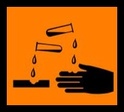 Mechanism of GI injury Damage is due to multiple factors: - tissue contact time - pH and concentration - ability of caustic to penetrate tissues - presence of absence of food in stomach - titratable acid/allkaline reserve (TAR) - amount of neutralizer needed to titrate pH of caustic to physiologic pH of tissues - higher TARs produce more damaged tissue Alkalis - injury is due to LIQUEFACTION NECROSIS - bad because injury keeps penetrating until neutralized or penetration of organ occurs - can get esophageal and gastric injuries > Sodium hydroxide > Sodium hypochlorite (household bleach) - worry about ingestion of larger amounts or higher concentrations > Ammonium hydroxide (toilet bowel cleaner) > Household detergents - usually dont cause GI injury but massive ingestions can be bad Acids - + ion causes COAGULATION NECROSIS - ulceration and perforation can occur; can get gap or nonanion gao acidosis; both esophageal and gastric injuries as well as pylorospasm Classification of caustic injury of esophagus Grade I - hyperemia - diet as tolerated, early D/C (likely need to be brought in initially for obs) Grade II - ulcerations and exudates Grade III - necrosis and deep ulcerations * Be aware - these people can have an initially benign presentation * Don’t use presence or absence of oral pharyngeal lesions to determine damage distally Management - Hydration - Steroids for airway edema (not research base) - CBC, lytes, VBG, coags - Not unusual to have GI bleed early on, but check type and cross - Airway - manage early (WEAR MASK), get good visualization - No NG tube for alkali ingestions, but with acid ingestions use w/in 30-60 min, don't do charcoal unless bad ingestion (ex, Zinc Chloride) - Endoscopy for all intentional ingestions - perform in first 12-48 hrs, up to 96 hrs is safe - unless they ingest very concentrated products or large amounts - then scope immediately - If you do not scope - observe for 6-12 hrs with serial exams and small sips of water - Contraindications to endoscopy - perforation, supraglottic or epiglottic burns (concern for perforation if you scope) - if can’t do endoscopy - perform esophagram and upper GI series 24 hrs after ingestion - use water soluble contrast initially Sequelae - scarring - motility issues - gastric outlet obstruction - tracheoesphogeal fistulas - strictures which SIGNIFICANTLY increases risk for Cancer - need lifelong monitoring
0 Comments
Your comment will be posted after it is approved.
Leave a Reply. |
Archives
August 2018
Categories
All
|
 RSS Feed
RSS Feed
